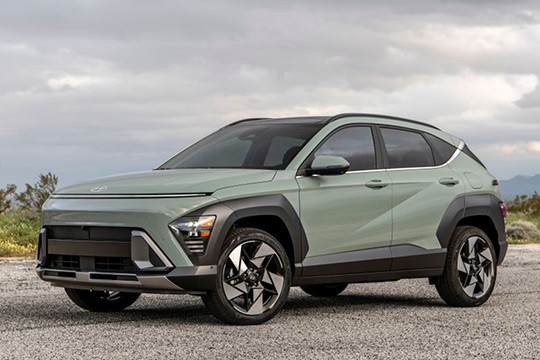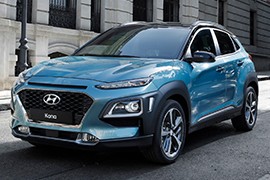HYUNDAI Kona Models/Series Timeline, Specifications & Photos
First production year: 2017
Engines: Gasoline, Diesel, Hybrid
Body style: SUV (Sports Utility Vehicle)
Hyundai developed the second generation of the Kona from the ground up to accommodate either electric or internal combustion engines, and the U.S. version broke covers on the 2023 NYIAS.
The Korean automaker focused on EV production but still knew that it had to keep the internal combustion versions on the assembly lines. As a result, it came up with a smart idea: a platform that could get both kinds of engines and room to spare for battery packs. The only thing that it couldn't solve was a design to fit both versions.
Thus, the dinosaur-juice-powered version looked more like an EV with a grille at the front rather than a proper ICE vehicle. At the front, the vehicle sported the same signature LED light strip that ran from side to side. Underneath it, the redesigned bumper accommodated a broad opening for the radiator's grille, flanked on the sides by the same headlights with amber blinkers as on the Kona EV. From its profile, the B-segment crossover featured sculptured door panels and black, unpainted cladding that surrounded the wheel arches and adorned the side sills. At the same time, at the back, the taillights were placed on the outer sides of the quarter panels.
Hyundai created a modern interior for the Kona, with two 12.3" displays on the dashboard. The one fronting the driver was for the instrument panel, while the one placed atop the center stack was for the infotainment system. In addition, a 12" HUD offered additional information to the driver, so they didn't need to take their eyes off the road. The vehicle provided enough room for five occupants on short jaunts, but on longer trips, the narrow bench seat in the back was not exactly comfortable for three adults.
The Kona's gasoline-powered version was available with a choice of two powerplants: a 2.0-liter Atkinson-cycle and a 1.6-liter turbocharged and direct fuel-injected version paired with a CVT or an 8-speed automatic tranny, respectively.
Hyundai kept its promise and introduced a mid-life cycle refresh to its Kona crossover in late 2020 for the 2021 model-year and brought more of a sophisticated design than a revamped drivetrain.
The Korean carmaker chose to name its vehicles after various U.S. locations such as Santa Fe, Tucson, or Kona. The latter was inspired by the western district of the Hawaii island. Sure, the Creta was named after an island from the Mediterranean sea, but that was the exception.
Hyundai's team introduced a few modifications to the car's look. Its daytime running lights were still mounted on top of the front fascia, like two light strips that pointed toward the grille. Unlike its electric-powered sibling, the version fitted with an internal combustion engine featured a black grille with a 3D mesh-grille. The design team considered that a silver shield would emphasize more the SUV style of the small crossover. They also installed LED headlights, which were a good addition to a 2021 vehicle.
Hyundai installed a completely digital instrument panel in front of the driver and an additional touchscreen display for the infotainment system placed on top of the center stack. On the other hand, the gear selector still looked like it was designed at least two decades before the car's introduction. The Korean carmaker improved the comfort of the rear seat's passengers by adding a pair of USB charging ports and raised all occupants' mood by introducing new ambient lighting.
Under the hood, Hyundai installed a choice of two engines: a turbocharged 1.6-liter for the N-Line version and a naturally aspirated 2.0-liter paired to a CVT. Both of them sent the power to the front wheels.
The 2017 Hyundai Kona was introduced in Korea and the North American and the European continents followed later that year. It completed the SUV lineup in the Korean car-maker stable.
The Hyundai Kona came late to the party in 2017. While most of the other European car-makers already had something to offer with more affordable or more expensive models, the Kona tried to make its own path by offering an outrageous design and a good platform. It was a direct competitor with the Nissan Juke, Seat Arona, Dacia Duster, and Peugeot 2008.
The front of the car featured two light strips on the upper part, as daytime running lights. The actual headlights were mounted in the front bumper. Even if it featured five air-intakes on the bumper, only three of them were used for something. Those from the sides were completely useless.
Inside, the Hyundai designers managed to offer enough room for five passengers and decent trunk size. The dashboard was simple and featured the navigation screen (offered as an option) on top of the center stack. It wasn't the best place, but it was the most affordable one.
The Kona was available with a choice of two exclusively gasoline engines and a hybrid version. Later on, a full electric version was introduced.


